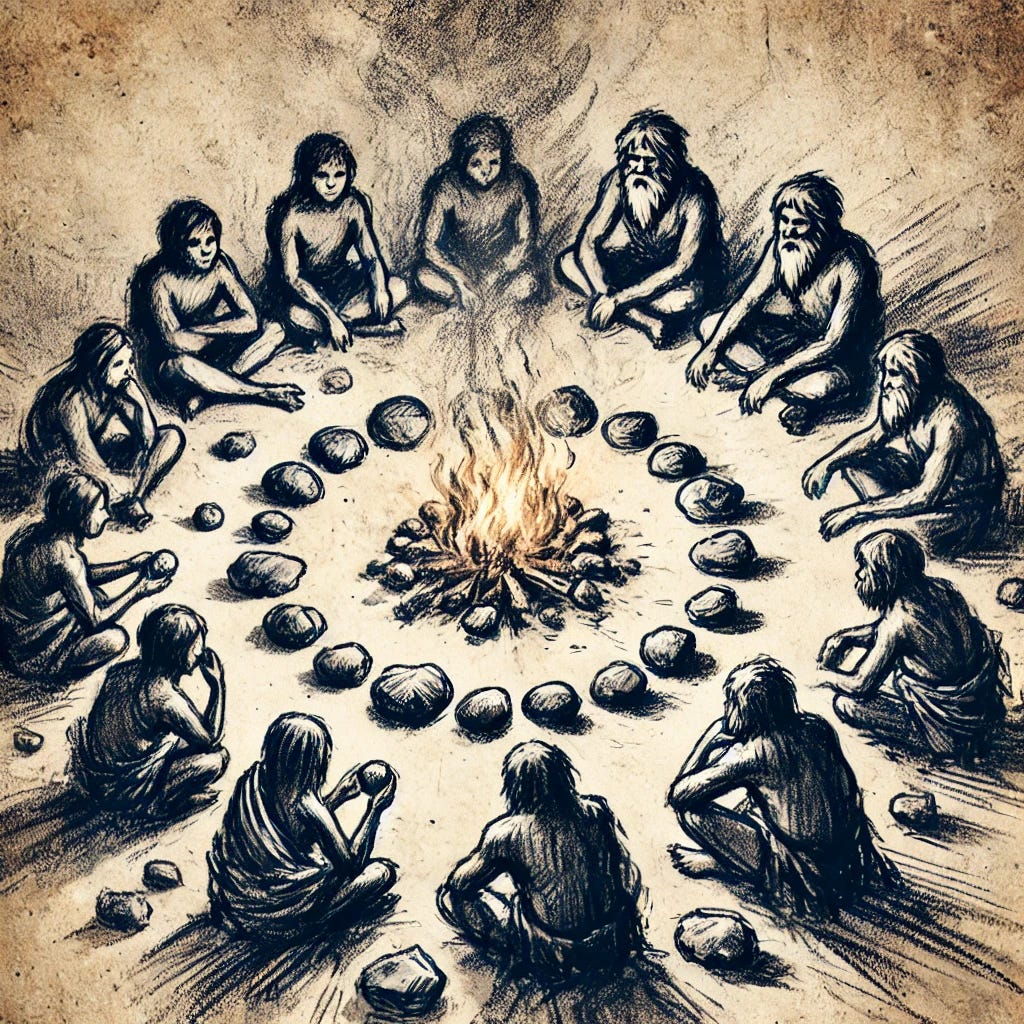Let's Invent Math
Sometimes I like to think about how math came to be. I love being able to imagine how it all began, even if I might only have the broadest of brush strokes for details.
Clearly, hunter-gatherers needed to understand ratios in order to survive—it was far better to run toward one lone animal than toward a pack of animals, for example, and that ability is even hard-wired into our DNA. Long before we had names for every number, we understood how to compare the size of groups or piles of things.
This pile has more things in it than that pile does is an incredibly useful statement, but it only goes so far without more precision, so we ultimately came around to inventing names that went with those numbers to describe piles of things more accurately.
This gives you an idea of how some of the very first abstract symbols came to form, and it goes a long way toward explaining other mathematical concepts. Addition and subtraction are pretty intuitive concepts, and it’s easy to imagine a physical situation where this concept was invented by lots of people in stages, each without really understanding they were inventing anything.
Imagine moving things from one pile to another, and you have the perfect physical example of addition and subtraction in action. You don’t need to remember any numbers or formulas here, since you’re physically moving things you can see and verify as you go.
Let’s say you’re trading with someone else. You have five bags of bananas to get your people through the next week, but you know they only need two bags, so you want to trade however many bags you can.
You certainly don’t want to run the risk of your people starving to death, so you want to make sure you don’t bring too many bags with you to trade. On the flip side, the last thing you want to do is waste those extra bags. That was a lot of hard work for you and your tribe!
The good thing is that you can count. You invented the idea of speaking a sound and having that sound correspond with the number of bags of bananas, and you really don’t need any hot new technology to solve this problem.
The only problem is that bags of bananas are pretty heavy. Here’s an idea: why not use little stones to represent them?
Or, if there are few enough bags, maybe just use those fingers you have on your hands. Incidentally, you can probably see (if you didn’t already know this) that we use a ten-digit system for counting today for exactly this reason. There’s nothing special about the number ten in nature, except for the fact that we (typically) have ten fingers.
Instead of fingers and physical objects, it’s way easier to just use some kind of written symbol to represent each of these ideas: numbers, addition, and subtraction.
Can we go a bit further with these tools alone, and come up with even better tools to use? In that question lies the very heart of mathematics.
Let’s consider a circle for a moment. People living thousands of years ago easily noticed that there was a ratio between how wide a circle was and how far around the circle went.
Now, you might wonder why anyone would have cared about this idea in the first place, and I might answer that in a few different ways. For one thing, I think it’s evident that our ancestors were every bit as curious as we are today.
I might argue that they were even more likely to think about the relationship between a circle and its diameter than we are today, since there weren’t so many distractions like the internet and TV to occupy that part of our minds.
I might also make the point that there could be a good reason for trying to figure out how far it would be around the circle if you knew how wide the circle was going to be. After all, you needed materials to build real things, and sometimes these materials were hard to come by.
It’s the banana bag situation all over again!
You didn’t really want to do a bunch of extra work for no good reason, particularly if that work involved you risking your life. Imagine knowing how far across something like Stonehenge was, then wanting to build a perfectly circular ring around it. It would be really, really helpful if you had some way to figure out how many stones you would need to create that ring.
Some brilliant ancestor of ours used that same trick of counting with their fingers, of representing something hard to move with something easy to move. Perhaps they thought about the problem like this: if you stretched a rope across the circle, you could always stretch that rope around the circle a little over three times.
A little over three times has a nice ring to it, and we still use “times” to talk about multiplication today. Instead of asking how many times something happened, though, we say a number times another number, and we understand that it doesn’t matter if you eat five bananas twice today, or two bananas five times tomorrow, so you could just talk in terms of one number times another number.
Our ancestors understood that there was a number of times the rope went around the circle, but not really the precise number. No matter, they figured: simply knowing that there was a number was helpful. One day, the ancient Greeks started using a letter to represent this mystical number, and today we still call this number π (spoken aloud, it sounds like "pie” and is written in English as pi).
With these representations of things from the real world, we can test out ideas quickly by writing them down and performing some of these math operations on them. Understanding how to trade banana bags means you also understand how to use the same tool anywhere else.
I find myself doing all sorts of quick math in my head. I estimate distances, times, and prices of things based on whatever information I have available, and that’s usually incomplete. I’m grateful to know how to do this; it’s incredibly useful in my day-to-day life.
I know that, if I need to, I can manipulate a few symbols that represent things in the real world. If I absolutely need to, I can write an equation down, or even just ask Google or a large language model for the answer. I’m grateful we don’t have to rely on our fingers, or on moving heavy stones around to count them.
This calls for a very bad dad joke, so I’ll leave you with one: orange you glad we don’t have to move banana bags around to count them?
What has math done for you in your own life? Did you measure how much water went into brewing coffee this morning, or use any of that fancy math in your GPS? Alternatively, do you have any better math-related dad jokes or punchy closing lines for me to use here? Is Hollaback Girl stuck in your head yet?







Me: "Damn. Another Monday. Let me check Substack real quick to distract myself from this sad realization."
Substack: "Let's Invent Math!"
Me: "This is going to be a long week."
To be fair, I was actually always pretty good at math. I even know that one thing is less than "more than one thing," for instance. #humblebrag
I’m pretty sure that before the Greeks, proportionality mattered more than π. While it’s nice not to have to move around banana bags, imagine living in a world where a fraction represents a share of an eternally growing spiral banana tree, rather than a single, perfect slice of a diminishingly divisible, flattened circle pi pie.
🌀> 🥧?